Drainage of the site itself: detailed instructions
Drainage at the dacha is necessary, since this system protects the house from excessive moisture. In the article we will tell how to properly drain, as well as show photos and video instructions for draining sites.
When is it necessary

To get rid of excess moisture in the summer cottage, in order to divert water, it is necessary to do a drainage of the territory by performing the installation of drainage systems. Vegetation will no longer be molested by bogs, puddles will not stay on deer paths and paths, there will be only time for a pleasant lesson in growing your own garden and relaxing with family or friends in the lap of nature.
Drainage systems are needed at summer cottages if the following troubles arise:
- Soil swelling. With this serious problem, the expanded and expanded soil destroys tile-trimmed paths and squeezes out the pool installed at a certain depth in the ground. In addition, with strong ground pressure, cracks in the bearing walls of buildings, as well as distortions of openings of windows and doors are possible.
- Soil erosion. With a strong shower, the formation of openings under the canvas of tracks and grooves in the garden in places of uneven and loose earth surface.
- Waterlogging of land. Clay soil does not absorb water well, which leads to its stagnation, the formation of puddles and dirt. All this adversely affects the vegetation, visually depresses the owners of the cottage and may even affect their well-being.
- Underfloor cellars and low cellars. Excessive humidity contributes to the development and reproduction of fungi and mold. This leads to the destruction of such premises, and the fruits and vegetables in them quickly deteriorate.
Additional factors
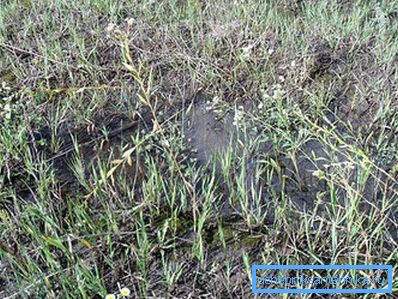
The need to remove excess water from the dacha largely depends on the groundwater level. When this indicator reaches - 2.50 m, this indicates a desirable drainage system, but if it is equal to - 1.50 m, it is simply necessary to equip the drainage. In addition, drainage is recommended if:
- the cottage with the adjacent territory is located on a hilly slope or under it;
- plot with country houses is in a lowland;
- The soil around the dacha has a clay structure and poorly filters water.
Kinds
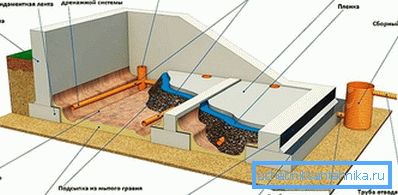
Deep drainage system
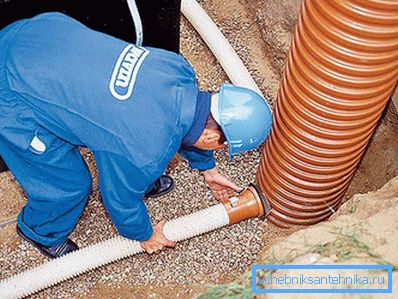
Such a system is most effective if the groundwater is close to the surface. It is used to protect basement premises from being flooded with the same groundwater during the period of heavy rains and the removal of excess moisture from the territory.
Tip! It is recommended to equip a drainage system on land areas for gardens and gardens in the event that the soil is clay.
Surface Drainage System
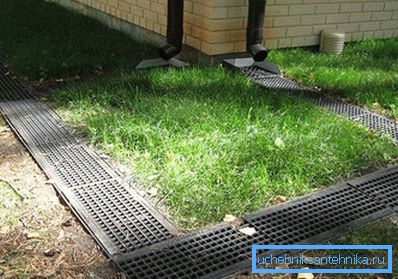
Such a system is a drainage of surface wastewater through storm sewers and has 2 subspecies:
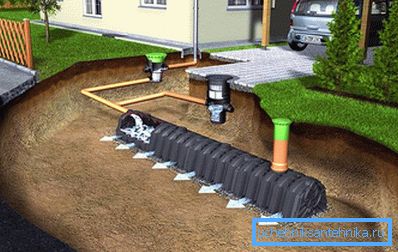
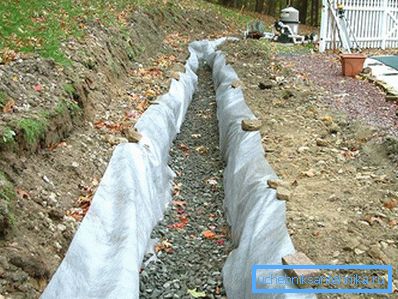
What type of drainage system is most appropriate in a particular situation can be learned from geological survey and geodetic surveys made by geologists and surveyors. Such services can be ordered from their respective organizations.
Deep drainage device
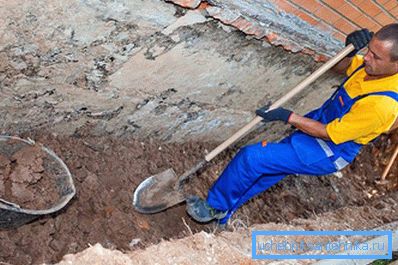
First you need to dig a trench, fill it with branches and improvised materials, which will create a natural filter, and fill it all up with earth. It will turn out not bad, cheap and angry, but, unfortunately, is short-lived.
Work on the equipment for deep drainage pass through the following stages:
- Geodetic works. To do this, you need to purchase a range finder (preferably a laser), a classic level and a geodetic rail. With the help of these devices it will be possible to determine the mark of pickets on the ground and the distance between them.
- Excavation work to create trenches for laying porous drainage pipes. The trench should be: 1 m (depth) x 0.4 m (width). The horizontal slope should be 0.03, increasing to 0.04 towards the lower part of the flow.
- The bottom of the trench is filled with 0.1 m thick rammed sand.
- Geotextile web is laid on the compacted sand, with the edges coming out to the side of the trench.
- A 20 cm layer of crushed stone is laid on top of the canvas.
- Drainage pipes are laid on the rubble with holes down.
- Repeated backfilling of rubble.
- Cloth, which will hold the soil particles, wrapped in a pipe with rubble.
- The top of the trench is closed with a roll of sod.
- At the final stage, a water intake well is installed at the lowest point of the drainage network, the water from which will be discharged into the storm sewer, ravine or reservoir.
Tip! Check the quality of the work of the deep drainage can be visually during heavy rain.
Surface drainage device

The manufacture of this type is much simpler than the one described above. In this case, do not need to dig a trench. The drainage of the soil can be carried out with the help of a lotkovaya or charging system. Work begins as standard:
- Geodetic processing of the area. Draw a drawing of the location of the trenches. Future trenches on paper cover the entire perimeter of the garden plot. From the places of maximum accumulation of water spend additional threads;
- Are trenches digging 0.7 m. (Depth)? 0.5 m. (Width). Trunk lines are dug up with a slope to the well, and the side lines to the main threads;
- The walls of the trench should have a slope according to the type of soil at the base and should be approximately 30?
With the charging method, rubble is laid in ditches at 66% of their depth, and 34% in height is occupied by the same crushed stone, but of a smaller fraction. Just as with the depth method, you can apply a geotextile canvas. The top of the structure is covered with a layer of turf.
With another method, you need to purchase ready-made trays that will perform the function of draining storm and drainage drains. They are produced mainly from concrete or plastic, as well as from a material made with the addition of polymer. To create a drainage tray system, the following work is performed:
- 0.1 m thick sand is laid in dug ditches, after which it is tamped;
- trays and sand traps are placed on the sand, which are plastic parts that hold back sand and dust fractions;
- trays are covered with gratings to protect them from various debris and make the structure more attractive.
Depending on the situation, you can limit water disposal around the perimeter of the house, and you can dig trenches to improve your landscape design. Having saved the area from the destructive excess moisture, the summer house will be the place where you can always have a good rest.
Video
In this video, a specialist in the field of drainage systems will talk about how to properly perform such work: